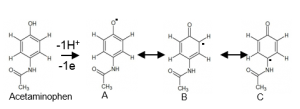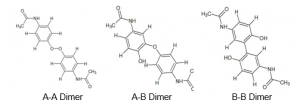Difference between revisions of "Acetaminophen Oxidation"
Ian Salveson (talk | contribs) |
Ian Salveson (talk | contribs) |
||
| Line 5: | Line 5: | ||
In order to determine the identities and properties of the single electron oxidation products, it is necessary to first synthesize them. The single electron oxidation can be accomplished by using a system of horseradish peroxidase (HRP) and hydrogen peroxide. HRP carries out two, single-electron oxidations of the substrate, APAP in this case. In regard, to acetaminophen the oxidation most likely will take place at the hydroxyl group of the phenol. The single electron oxidations result in the formation of a reactive radical intermediate which can move exist in several different resonance structures as shown below in figure 1. These radicals have the ability to link; however, due to steric hindrance, resonance structure C is less likely to link. The remaining possible radical dimers are illustrated below in figure 2. Dimer A-A is a peroxide and will be consumed as fuel for the peroxidase cycle. The remaining dimers have a hydroxyl group available to be oxidized again. Repeated oxidations and linkages would result in the formation of polymeric material. | In order to determine the identities and properties of the single electron oxidation products, it is necessary to first synthesize them. The single electron oxidation can be accomplished by using a system of horseradish peroxidase (HRP) and hydrogen peroxide. HRP carries out two, single-electron oxidations of the substrate, APAP in this case. In regard, to acetaminophen the oxidation most likely will take place at the hydroxyl group of the phenol. The single electron oxidations result in the formation of a reactive radical intermediate which can move exist in several different resonance structures as shown below in figure 1. These radicals have the ability to link; however, due to steric hindrance, resonance structure C is less likely to link. The remaining possible radical dimers are illustrated below in figure 2. Dimer A-A is a peroxide and will be consumed as fuel for the peroxidase cycle. The remaining dimers have a hydroxyl group available to be oxidized again. Repeated oxidations and linkages would result in the formation of polymeric material. | ||
| − | [[File:Radical_intermediates.png|Thumb|left|300px|alt=Figure 1: Radial Intermediates|Figure 1: Radical Intermediates]] [[File:Radical_couplings.png|Thumb | + | [[File:Radical_intermediates.png|Thumb|left|300px|alt=Figure 1: Radial Intermediates|Figure 1: Radical Intermediates]] [[File:Radical_couplings.png|Thumb|300px|alt=Figure 2: Radical Dimers|Figure 2: Radical Dimers]] |
| + | |||
| + | ==Synthesis and Isolation== | ||
| + | The single-electron, oxidation products are synthesized using the system of HRP and hyrdogen peroxide. To confirm the formation of products HPLC was performed on the final solution. Reverse phase HPLC was utilized with a gradient of acetonitrile and 0.1% trifluoroacetic acid. Figure 4 below shows a typical product chromatogram with stoichiometric levels of hydrogen peroxide. As hydrogen is the limiting reagent in the system, it can be used to control the level of oxidation and the levels of different products. Figure 5 below shows how the products change with different levels of hydrogen peroxide. For further analysis it was necessary to isolate specific products. This was done by preparative column chromatography. Figure 6 shows a sample chromatogram of one set of fractions. | ||
| + | |||
| + | [[File:APAP_oxidation_chromatogram.png]] | ||
Revision as of 19:06, 21 March 2016
Introduction
Acetaminophen(APAP) is an active ingredient in many over-the-counter and prescription painkillers, such as Tylenol and Oxycodone. APAP is also responsible for approximately 50% of the cases of acute liver-failure in the United States and Great Britain(1). Treatments for acetaminophen-induced liver injury(AILI) are limited. The current mechanism for AILI is the production of hepatotoxic NAPQI as a metabolite in an enzymatic, two-electron oxidation(1). However, evidence also supports a one electron oxidation(2). In on effort to reduce the mortality rate of acetaminophen overdose, we are investigating the identity of single-electron, oxidation products and their bioactivity as an alternative mechanism for AILI. Currently, there is no effective treatment for AILI. The first step towards achieving this would be to definitively determine the mechanism of acetaminophen metabolite toxicity.
Methods and Concepts
In order to determine the identities and properties of the single electron oxidation products, it is necessary to first synthesize them. The single electron oxidation can be accomplished by using a system of horseradish peroxidase (HRP) and hydrogen peroxide. HRP carries out two, single-electron oxidations of the substrate, APAP in this case. In regard, to acetaminophen the oxidation most likely will take place at the hydroxyl group of the phenol. The single electron oxidations result in the formation of a reactive radical intermediate which can move exist in several different resonance structures as shown below in figure 1. These radicals have the ability to link; however, due to steric hindrance, resonance structure C is less likely to link. The remaining possible radical dimers are illustrated below in figure 2. Dimer A-A is a peroxide and will be consumed as fuel for the peroxidase cycle. The remaining dimers have a hydroxyl group available to be oxidized again. Repeated oxidations and linkages would result in the formation of polymeric material.
Synthesis and Isolation
The single-electron, oxidation products are synthesized using the system of HRP and hyrdogen peroxide. To confirm the formation of products HPLC was performed on the final solution. Reverse phase HPLC was utilized with a gradient of acetonitrile and 0.1% trifluoroacetic acid. Figure 4 below shows a typical product chromatogram with stoichiometric levels of hydrogen peroxide. As hydrogen is the limiting reagent in the system, it can be used to control the level of oxidation and the levels of different products. Figure 5 below shows how the products change with different levels of hydrogen peroxide. For further analysis it was necessary to isolate specific products. This was done by preparative column chromatography. Figure 6 shows a sample chromatogram of one set of fractions.


